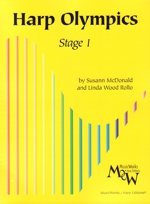
Introduction to Harp Olympics - Notes to the Teacher
Stage I of Harp Olympics is designed for the beginning harpist with basic note - reading and rhythmic skills. A child who has played the piano for one to two years should use this book. The student without any previous musical training should begin with the Preliminary Round of Harp Olympics.
Harp Olympics is designed to be used by teachers of all methods and schools. Only very general suggestions for position (form) are given. In each of the different sections the pace may be altered according to the varying needs and gifts of the student.
In the beginning stages of Harp Olympics the intent is to have the student, first of all, enjoy playing the harp while developing good'form and suppleness. Speed is not encouraged until the teacher is satisfied with the student's form - as is true in any athletic endeavor. It is important for the student to understand the long-term value of good position. To encourage this, special boxes have been placed periodically for the teacher and student to check position before continuing. Space is provided for the teacher to add any special points to be emphasized.
Since the development of memorization is very important for the harpist, it is urged that the student do some memory work each week, certainly all of the solo rounds and any supplementary repertoire the teacher wishes to assign. Children memorize very easily and are able to absorb greater and greater quantities, as long as it is done progressively.
It is hoped that each weekly lesson will naturally include some Work-Outs (technique), Games and Drills (note-reading and musicianship) and Solo Rounds ( easy progressive pieces) — giving the student a balanced and enjoyable program of study. Harp Olympics is intended to prepare the student to move smoothly into standard etudes and solo repertoire.
The use of improvisation is encouraged throughout Harp Olympics. Children love to make up their own pieces. The teacher may wish to elaborate on the suggested ideas for improvisations. The teacher may also wish to vary the exercises by the use of transposition to other keys.
The qualifying Marathons at the end of each book will serve as a review of all the material covered and be an incentive for the student to progress to the following stage. Three or more solos should be performed by memory at the same time and be noted on the certificate.
It would be desirable for the teacher to make the Marathon a special occasion for the student, signifying a certain level of accomplishment.
As each stage of Harp Olympics is completed it is recommended that the student continue to perform for the teacher the Marathons from the previous stages as a matter of review.
Contents
Introduction to Harp Olympics
Equipment Check/General Information
Non - pedal harp
Pedal harp
Pedals and Levers
More Parts of the Harp
Range of the Harp
Tuning
Replacing Strings
The Harp Doctor
Workouts
Rules of the Game & Personal Fouls
Form Check
I. Work Outs
A. Four - Finger Warm Ups Mixed Relays
B. Three - Finger Warm Ups
C. One and Two Finger Warm Ups
D. Balance Beams (Thirds)
E. More Balance Beams
F. Sliding (The Glissando)
G. More Balance Beams
H. Turn - around Glisses
I. Muffle
J. More Balance Beams (Fifths) Pole Vault
K. Walking
L. More Walking
M. Skipping, Cartwheels
N. More Balance Beams (Sixths)
O. Harmonics
P. Pivots and Changes of Direction
Q. Sevenths and Octaves
Games and Drills
Signs and Symbols
Review of the Great Staff
Notes and Rests Review
Time Signature Review
Pedals and Levers
Count and Tap
Dotted Notes
Count and Tap
Leger Lines
Review of Flats, Sharps & Natural Signs
Whole Steps and Half Steps
Intervals - Thirds - Fifths
Triplets
Key Signatures
Sight - Reading
Dynamic Drills
Brain Drills
Home Games
Brain Drills
Home Games
Improvisation
Memory Game
Stage I Solos
Chinese Moon
Little Waltz
Leap Frog
Dreaming
The Cuckoo
Carnival Suite
I. The Clown
II. Acrobat Swinging
III. House of Mirrors
IV. The Juggler
Scarborough Fair (Harp and Voice or Instrument)
Away in a Manger
Silent Night
Chanukah, Chanukah
Stage I Marathon
1. Work Outs
2. Games and Drills
A. Signs and Symbols
B. Tempo (speed) Signs
C. Count and Tap
D. Brain Drills
E. Pedals and Levers
3. Solo Rounds
Harp Olympics Certificate - Stage I
----------------------------------------------
Other recommended music by Susann McDonald and Linda Wood for use in Stage I
Graded Recital Pieces Volume 1
Haiku for the Harp -"A Stray Cat, Asleep on the roof In the spring rain."